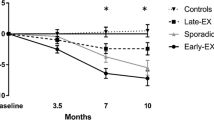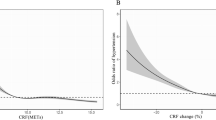Abstract
Sustained improvements in cardiovascular fitness and body composition after lifestyle interventions are challenging. The present study investigated whether changes in cardiovascular fitness and body composition were maintained for up to 1 year after similar exercise-induced (T) or diet-induced weight loss (D) or exercise without weight loss (T-iD) in overweight sedentary men. Six and 12 months after the interventions, we measured cardiovascular fitness and body composition. Cardiovascular fitness was higher at both 6- (3.2±1.5 ml O2/kg/min, P=0.053) and 12-month follow-up (3.9±1.4 ml O2/kg/min, P=0.049) compared with pre-intervention in T. Fat mass (−3.0±1.2 kg, P=0.04) and abdominal fat (−3.6±1.5%, P=0.04) were lower within T at 12-month follow-up compared with pre-intervention. This did not occur in D (P>0.13) or T-iD (P>0.14), although body weight was lower in D (−2.5±2.2 kg, P=0.09). This study showed that fitness and fatness were not returned to pre-intervention levels 1 year after a 3-month exercise-induced weight-loss intervention.
This is a preview of subscription content, access via your institution
Access options
Subscribe to this journal
Receive 12 print issues and online access
$259.00 per year
only $21.58 per issue
Buy this article
- Purchase on Springer Link
- Instant access to full article PDF
Prices may be subject to local taxes which are calculated during checkout


Similar content being viewed by others
References
Shaw K, Gennat H, O'Rourke P, Del MC . Exercise for overweight or obesity. Cochrane Database Syst Rev 2006; CD003817.
Dombrowski SU, Knittle K, Avenell A, Araujo-Soares V, Sniehotta FF . Long term maintenance of weight loss with non-surgical interventions in obese adults: systematic review and meta-analyses of randomised controlled trials. BMJ 2014; 348: g2646.
Lindstrom J, Ilanne-Parikka P, Peltonen M, Aunola S, Eriksson JG, Hemio K et al. Sustained reduction in the incidence of type 2 diabetes by lifestyle intervention: follow-up of the Finnish Diabetes Prevention Study. Lancet 2006; 368: 1673–1679.
Ross R, Dagnone D, Jones PJ, Smith H, Paddags A, Hudson R et al. Reduction in obesity and related comorbid conditions after diet-induced weight loss or exercise-induced weight loss in men. A randomized, controlled trial. Ann Intern Med 2000; 133: 92–103.
Ross R, Blair S, de LL, Despres JP, Lavie CJ . Changing the endpoints for determining effective obesity management. Prog Cardiovasc Dis 2015; 57: 330–336.
Nordby P, Auerbach PL, Rosenkilde M, Kristiansen L, Thomasen JR, Rygaard L et al. Endurance training per se increases metabolic health in young, moderately overweight men. Obesity (Silver Spring) 2012; 20: 2202–2212.
Myers J, McAuley P, Lavie CJ, Despres JP, Arena R, Kokkinos P . Physical activity and cardiorespiratory fitness as major markers of cardiovascular risk: their independent and interwoven importance to health status. Prog Cardiovasc Dis 2015; 57: 306–314.
Ostergaard JN, Gronbaek M, Schnohr P, Sorensen TI, Heitmann BL . Combined effects of weight loss and physical activity on all-cause mortality of overweight men and women. Int J Obes (Lond) 2010; 34: 760–769.
Jakicic JM, Jaramillo SA, Balasubramanyam A, Bancroft B, Curtis JM, Mathews A et al. Effect of a lifestyle intervention on change in cardiorespiratory fitness in adults with type 2 diabetes: results from the Look AHEAD Study. Int J Obes (Lond) 2009; 33: 305–316.
Wing RR, Phelan S . Long-term weight loss maintenance. Am J Clin Nutr 2005; 82: 222S–225S.
Acknowledgements
Danish National Research Council; the Ministry of Culture, Committee on Sports Research; the Academy of Muscle Biology, Exercise and Health Research (AMBEHR); the Novo Nordisk Foundation; the Danish Diabetes Association; Aase og Ejnar Danielsens Fond; Oda og Hans Svenningsens Fond; Fonden til Lægevidenskabens Fremme; Else og Mogens Wedell-Wedellsborgs Fond, Fonden af 17.12.1981; Beckett-Fonden and Direktør J. Madsen og hustru O. Madsens Fond and Fitness.dk. Salary of Mads Rosenkilde was funded by the University of Copenhagen Excellence Programme for Interdisciplinary Research through the research program ‘Governing Obesity’ (www.go.ku.dk).
Disclaimer
The financial sponsors had no role in designing or conducting of the study, in the collection, analysis or interpretation of data, or in the preparation of the manuscript.
Author information
Authors and Affiliations
Corresponding author
Ethics declarations
Competing interests
The authors declare no conflict of interest.
Rights and permissions
About this article
Cite this article
Rosenkilde, M., Nordby, P. & Stallknecht, B. Maintenance of improvements in fitness and fatness 1 year after a 3-month lifestyle intervention in overweight men. Eur J Clin Nutr 70, 1212–1214 (2016). https://doi.org/10.1038/ejcn.2016.64
Received:
Accepted:
Published:
Issue Date:
DOI: https://doi.org/10.1038/ejcn.2016.64



